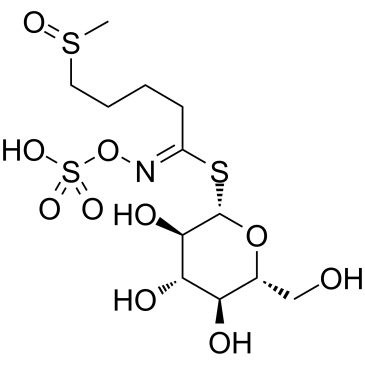
Glucoraphanin
CAS No. 21414-41-5
Glucoraphanin( —— )
Catalog No. M21773 CAS No. 21414-41-5
Glucoraphanin reduces weight gain and increases energy expenditure in HFD-fed mice. Glucoraphanin can improves insulin sensitivity and glucose tolerance in HFD-fed mice.
Purity : >98% (HPLC)
 COA
COA
 Datasheet
Datasheet
 HNMR
HNMR
 HPLC
HPLC
 MSDS
MSDS
 Handing Instructions
Handing Instructions
| Size | Price / USD | Stock | Quantity |
| 5MG | 105 | In Stock |


|
| 10MG | 178 | In Stock |


|
| 25MG | 372 | In Stock |


|
| 50MG | 597 | In Stock |


|
| 100MG | Get Quote | In Stock |


|
| 200MG | Get Quote | In Stock |


|
| 500MG | Get Quote | In Stock |


|
| 1G | Get Quote | In Stock |


|
Biological Information
-
Product NameGlucoraphanin
-
NoteResearch use only, not for human use.
-
Brief DescriptionGlucoraphanin reduces weight gain and increases energy expenditure in HFD-fed mice. Glucoraphanin can improves insulin sensitivity and glucose tolerance in HFD-fed mice.
-
DescriptionGlucoraphanin reduces weight gain and increases energy expenditure in HFD-fed mice. Glucoraphanin can improves insulin sensitivity and glucose tolerance in HFD-fed mice. However, Glucoraphanin does not exert antiobesity and insulin-sensitizing effects in Nrf2?/??Mice. Glucoraphanin blocks HFD-induced reduction of Ucp1 protein levels in white adipose depots of wild-type mice but not in Nrf2?/??mice. Glucoraphanin alleviates HFD-induced hepatic steatosis and oxidative stress. Glucoraphanin suppresses HFD-induced proinflammatory activation of macrophages in liver and adipose tissue. Glucoraphanin also decreases circulating LPS and the relative abundance of proteobacteria in the gut microbiomes of HFD-fed mice. Mice with pellets including 0.1% Glucoraphanin (GF) significantly attenuates the decreased social avoidance time in stressed mice. In the 1% sucrose preference test (SPT), treatment with pellets including 0.1% GF significantly attenuates the decreased sucrose preference of stressed mice.
-
In Vitro——
-
In VivoGlucoraphanin reduces weight gain and increases energy expenditure in HFD-fed mice. Glucoraphanin can improves insulin sensitivity and glucose tolerance in HFD-fed mice. However, Glucoraphanin does not exert antiobesity and insulin-sensitizing effects in Nrf2?/? Mice. Glucoraphanin blocks HFD-induced reduction of Ucp1 protein levels in white adipose depots of wild-type mice but not in Nrf2?/? mice. Glucoraphanin alleviates HFD-induced hepatic steatosis and oxidative stress. Glucoraphanin suppresses HFD-induced proinflammatory activation of macrophages in liver and adipose tissue. Glucoraphanin also decreases circulating LPS and the relative abundance of proteobacteria in the gut microbiomes of HFD-fed mice. Mice with pellets including 0.1% Glucoraphanin (GF) significantly attenuates the decreased social avoidance time in stressed mice. In the 1% sucrose preference test (SPT), treatment with pellets including 0.1% GF significantly attenuates the decreased sucrose preference of stressed mice.
-
Synonyms——
-
PathwayOthers
-
TargetOther Targets
-
Recptor——
-
Research Area——
-
Indication——
Chemical Information
-
CAS Number21414-41-5
-
Formula Weight437.51
-
Molecular FormulaC??H??NO??S?
-
Purity>98% (HPLC)
-
SolubilityH2O : ≥ 76.5 mg/mL (174.85 mM)
-
SMILESCS(CCCC/C(S[C@@H]1O[C@@H]([C@@H](O)[C@H](O)[C@H]1O)CO)=N\OS(=O)(O)=O)=O
-
Chemical Name——
Shipping & Storage Information
-
Storage(-20℃)
-
ShippingWith Ice Pack
-
Stability≥ 2 years
Reference
1. Nagata N, et al. Glucoraphanin Ameliorates Obesity and Insulin Resistance Through Adipose Tissue Browning and Reduction of Metabolic Endotoxemia in Mice. Diabetes. 2017 May;66(5):1222-1236.
2. Yao W, et al. Role of Keap1-Nrf2 signaling in depression and dietary intake of glucoraphanin confers stress resilience in mice. Sci Rep. 2016 Jul 29;6:30659.
molnova catalog



related products
-
CTPI-2
CTPI-2 is an inhibitor of mitochondrial citrate carrier SLC25A1 with(KD : 3.5 μM).?CTPI-2 inhibits glycolysis, PPARγ, and its downstream target the glucose transporter GLUT4.?
-
SPQ
SPQ is used to measure membrane chloride transport mechanisms.
-
Dehydrovomifoliol
Dehydrovomifoliol could be a marker of Polish heather honey. Dehydrovomifoliol exhibits moderate acetylcholinesterase (AChE) inhibitory activities.



 Cart
Cart
 sales@molnova.com
sales@molnova.com


